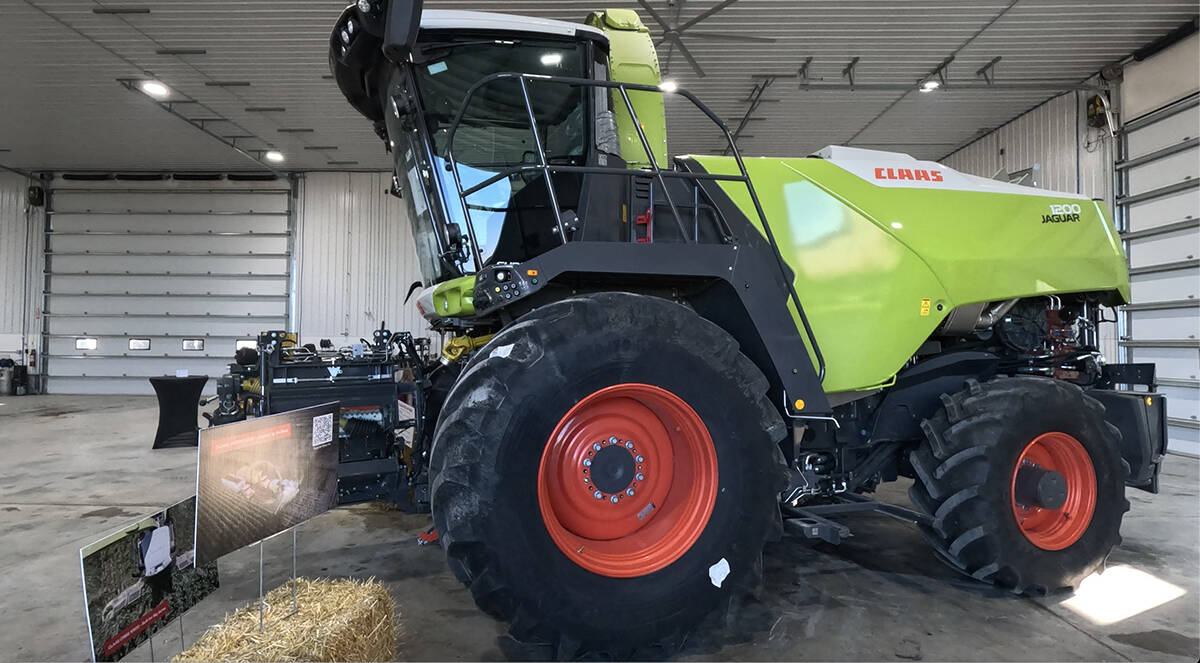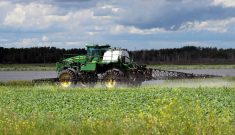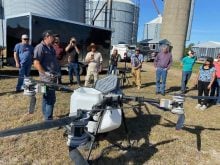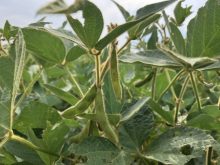After struggling though tough early-season conditions, Ontario’s soybean crop delivered a surprisingly good average yield, perhaps edging into record territory.
Speaking during a Nov. 6 webinar hosted by Grain Farmers of Ontario, provincial soybean specialist Horst Bohner said that, at that point, about one-fifth of the province’s yield reports had been submitted to Agricorp, ahead of a mid-December deadline. The majority reported higher numbers than their average farm yield.
Why it matters: Ontario soybean growers were rewarded for their decision to stick with their original plantings despite discouraging early season weather.
Read Also

Claas brings 1000 Series SP forage harvesters to Canada
In mid-August, Claas unveiled its new line of Jaguar forage harvesters at an event in Visalia, California, deep in the heart of that state’s dairy region.
This follows on an estimate of 54 bushels per acre, which would be an all-time high, offered in late August during the seed company-sponsored Great Ontario Yield Tour. Bohner noted he’d just received plot results from the Winchester research station, and some of them yielded over 100 bushels an acre.
Until these yields arrived, the biggest story of the year was the early-season challenges due to wet conditions. Persistent rains through April, May, June and even into July led to numerous challenges.
Decisions by many cash croppers to abandon corn-planting plans and move to soybeans led to a higher-than-average acreage total. Statistics Canada data indicate a 7.6 per cent increase in soybean acreage compared to 2023, settling at approximately 3.1 million acres.
But Bohner noted there was also “considerable unseeded acreage,” that would have been in soybeans, “especially down in Lambton County and a few other pockets.”
Much of the acreage was either planted very late (sometimes into July) or sat in waterlogged conditions for longer than growers wanted to see.
Stick to it
A lesson reiterated in 2024 was that, despite the “tremendous amount of planting date (research) work that has been done,” Bohner said, “you don’t give up on soybeans.”
“We had plots planted on the last day of June. And we know that … we’re not expecting to harvest a lot of crop from soybeans planted on the last day of June. But we got 50 bushels (to the acre).
“So even though planting date is delayed, you still have to think about what you’re comparing it to. (A late planting date) doesn’t always mean you’re going to get 35 bushels. You might not get 70 but you might still get 50 or 55.”
Bohner showed a photo of two tractors with tillage and planting equipment sitting in a Lambton County field on June 11. The tractors were clean because they’d been washed by the rain, but the field they were sitting in wasn’t clean.
“Weed control was a problem in some of those fields,” where field activities were delayed, he said. “Some fields had two applications of a burndown before they were even seeded. (In some fields), the weeds were incredible and the beans weren’t even planted.”
Of the yield reports submitted to Agricorp by Nov. 6, the range was considerable, from 20 to 70 bushels per acre. There were definitely fields that suffered from the early-season moisture and its repercussions.
But as demonstrated by the predicted overall yield average, a surprising number of wet fields emerged in August with limited long-term damage.
“I live in Stratford (and) we just had a tremendous number of these really heavy downpours,” Bohner noted. “But the good thing about soybeans is that, as long as they’re not dead, they often do better in those waterlogged conditions than we fear.”
He showed a series of photos of a field that did well despite standing water in a good part of the field a number of times. That shows soybeans can survive despite the commonly held notion that two days of being underwater will kill the crop, Bohner said.
“It depends on the temperature, how cloudy it is and the growth stage. Sometimes they can survive up to a week underwater.”
A photo from June 17 in another field showed beans that had emerged unevenly and were sitting in muddy sediment.
“Beans that look like this in the spring, even if you don’t have to replant them, are not a bumper crop,” Bohner said. “They turn out OK if the rest of the season is reasonable. Average, but they don’t turn into a 65-bushel crop usually.
“But this year, even some of those managed to come back and surprise us.”
Poor nodulation is one outcome of waterlogged conditions. Bohner showed an uprooted soybean plant from late July with very few nodules on the root. Vermey commented that it seemed unlikely at the time that some Ontario fields would achieve any nodulation.
Yet harvest season proved that prediction wrong, for the most part. Vermey wondered if growers should consider applying more inoculant in wet years.
“We hear of wet places around the world where they have to put on double the amount,” the senior agronomist noted.
Bohner said there’s no evidence to support this here.
“In our inoculant trials in Ontario in a field with a history of beans, we’re still only getting a bushel or a bushel-and-a-half (yield response). I’ve tried up to 10 times the rate of inoculant to try and super-load the system … and we get about a bushel.
“The established bacteria in the field seem to overtake anything new that we’re putting on.”















